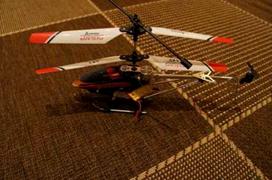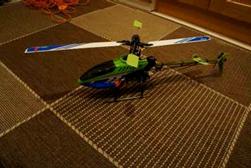

 Whirlybirds
WhirlybirdsGeoge Whelan - Dec 2010
The unlikely highlight of last Christmas was the receipt of a Micro Twister indoor helicopter, this diminutive ‘toy’ heli is guaranteed to make you smile. The Twister uses concentric twin main rotors and an electric tail rotor. After getting to grips with the 2 basic controls I was able to hover and move the Twister in approximately the right direction.
BRC Hobbies and various gadget shops in Aberdeen. The Twister has a metal chassis and comes with spare rotor blades, BRC sell all the spare breakable bits. I’m not sure if the Twister works by radio or IR, the package has a transmitter with lots of blinky lights on and a choice of A, B or C frequency, WARNING, if there are a number of Twisters to fly speak to the other pilots to decide who is on what frequency, they might be toys but the law of physics still applies.  For such a small heli it is surprising how rock steady it is. The twister can be charged from the transmitter or from a USB cable.
For such a small heli it is surprising how rock steady it is. The twister can be charged from the transmitter or from a USB cable.
Over the months I became adept at landing it on and off the coffee table, walking it from room to room and even going upstairs. This is a fun way to keep your thumb in on the non flying days we occasionally get in Aberdeen. The Micro twister is available from After the inaugural indoor meet at the Police Gym in November I decided I wanted something a bit bigger. Coming up to Christmas the shops around Aberdeen were full of helicopters from the sublime to the ridiculous. I had a good look at most of these, some I dismissed as they were mostly plastic and I wanted something more robust, the Discovery has a metal chassis, one I dismissed as it was on 27mHz, I finally settled on the Discovery from the Discovery Store. Again the Discovery has concentric twin main rotors and electric tail rotor. I was impressed by the demo given by a small boy, the model was rock solid to fly, although slightly dearer than similar models it has a built in gyro which irons out the twitchy thumb. I must admit I also had an ulterior motive for buying this model, it looks big enough for conversion to 2.4 GHz some time over the Winter. Subsequent surgery revealed of course that this type of heli doesn’t use servo’s but an integrated radio and motor drive board.
 The down side is that all the models in the shop have the identical frequency so a bit of frequency control is required. The Discovery has a 1000 mah lipo and is charged from a dedicated charger, I put rechargeable Enerloop batteries in the supplied transmitter.
The down side is that all the models in the shop have the identical frequency so a bit of frequency control is required. The Discovery has a 1000 mah lipo and is charged from a dedicated charger, I put rechargeable Enerloop batteries in the supplied transmitter.
The third model is the Belt CP V2, I bought this because I wanted a bind & fly helicopter on 2.4 GHz, you know the way it is, you start looking around and for a few pound more you get a bit more and a few pound more, more again and before you know it you have the Rolls Royce version. While I didn’t go that far the Belt is a single rotor variable pitch helicopter, i.e. the real deal. I looked hard at the Belt and the Blade SR, both bind & fly, i.e. I could use my Spektrum transmitter.
 The reason I eventually settled on the Belt was the tale boom is tubular metal, the SR uses a carbon rod, the other reason is the SR has a brushed main drive motor, the Belt has a brushless motor. One of the reasons the Belt has a tubular tail boom is it contains a tail rotor drive belt, the SR has the usual electric drive tail rotor. I have not yet flown this model, it has been wrapped up by my wife as a surprise Christmas present for me, but there are plenty of demo’s on YouTube. I think initially I will go with the supplied transmitter as it is set up for the heli, until I understand about swash plates and teeter heads and gyroscopic precession before I attempt to change over to the Spektrum, watch this space. The Belt has a 1200 mah battery and again Enerloops in the dedicated TX. This is a heli for next year starting in the middle of the biggest field available. Probably the Blade SR would have been more appropriate. Watch this space.
The reason I eventually settled on the Belt was the tale boom is tubular metal, the SR uses a carbon rod, the other reason is the SR has a brushed main drive motor, the Belt has a brushless motor. One of the reasons the Belt has a tubular tail boom is it contains a tail rotor drive belt, the SR has the usual electric drive tail rotor. I have not yet flown this model, it has been wrapped up by my wife as a surprise Christmas present for me, but there are plenty of demo’s on YouTube. I think initially I will go with the supplied transmitter as it is set up for the heli, until I understand about swash plates and teeter heads and gyroscopic precession before I attempt to change over to the Spektrum, watch this space. The Belt has a 1200 mah battery and again Enerloops in the dedicated TX. This is a heli for next year starting in the middle of the biggest field available. Probably the Blade SR would have been more appropriate. Watch this space.